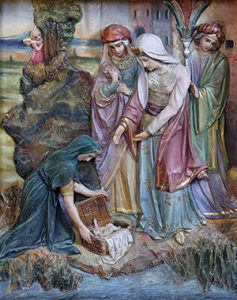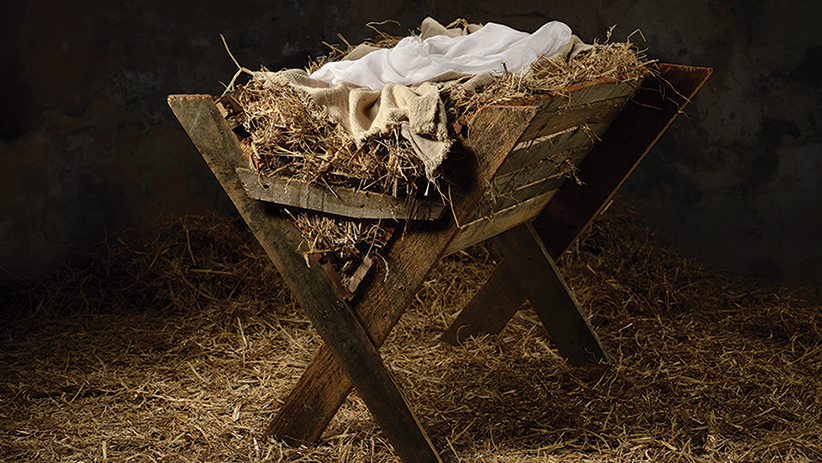Many Catholics are unaware that Advent is a penitential time in which we prepare for the Lord’s coming at the end of time. One way to prepare for that is to reflect on the Lord’s coming in time — that first Christmas — and reacquainting ourselves with a careful study of the greatest sources we have for the story of Our Lord’s birth: the Gospel passages of Matthew 1-2 and Luke 1-2 called the Infancy Narratives.
The Christmas story that most Catholics know is actually an amalgamation of the accounts of the events of Christ’s birth according to Matthew and Luke. Harmonizations like this serve a good purpose — without them we would not have the Nativity scene or the annual school Christmas pageant — but there is a great deal to be learned by reading the two accounts as their authors actually wrote them — that is, as the prelude to two separate Gospels which each shed separate light on the Christ event.
Fulfilling Old Testament
Many will find a few surprises within the Infancy Narratives. For instance, while we see that the baby is wrapped in swaddling clothes (just like King Solomon in Wisdom 7:4-6), neither Luke nor Matthew mention any animals present at the birth. The idea that an ox and ass were present came from a creative reading of Isaiah 1:3, which speaks of these animals at the “manger,” the master’s crib. No stable or cave is mentioned in either Gospel, and there is a decent possibility that the feedbox in which the baby Jesus was laid was used to feed animals kept at the house where Joseph was forced to put the baby because he had run out of space in his room.
The word in Luke 2:7 usually translated “inn” is not the usual word for inn that we see later on in Luke 10:34. The term in Luke 2:7 is more the generic term for “accommodation,” so it may be that Joseph has his own ancestral house in Bethlehem, his town of origin, where he must go to enroll in the census. This would fit Matthew’s version in which he speaks of a “house” in Bethlehem (see Mt 2:11) where the Magi visit. At any rate, Bethlehem is important as a place because it fulfills the prophecy in Micah 5:2.
In the Line of David
But as interesting as it is to speculate on details surrounding the birth of Jesus, there is a great deal also to be learned from the more mundane aspects of the stories — and nothing is more mundane to Western ears than the genealogies — Jesus’ family history. Matthew’s genealogy might be recognized as the Gospel reading at the Christmas Vigil Mass. Perhaps boring to us, it is the most exciting thing to Jewish ears because it speaks of the return of the long-awaited Davidic king! All of Jesus’ ancestors listed from David down to Josiah, all once sat upon the throne of Judah.
Besides this, Matthew has made the curious choice to include four women in his genealogy of Jesus — Tamar, Rahab, Ruth and Bathsheba. Each woman was important in her respective biblical story while at the same time being of questionable repute. (See Genesis 38 for the story of Tamar and Joshua 2 concerning Rahab.) Bathsheba’s indiscretions with David are, of course, pretty well known.
The mention of these women, then, has three functions. First, the Gentile identity of each of the women establishes the international basis of Jesus’ background, hinting at the Abrahamic promise to bless the nations through the Davidic line (see Gn 12:1-3; 17:1-8; 22:15-19), thus explaining why Jesus is called “son of Abraham” (Mt 1:1). Second, it prepares the reader for the marriage between Mary and Joseph and the apparent impropriety that surrounded that case. But, third, including these four women in Jesus’ family tree also serves to connect Jesus even to the less savory aspects of the Davidic family. This is fitting, since as one who has come to save His people from their sins, Jesus stands as someone who bears on His shoulders the full weight of the transgressions of the house of Judah.
But the Davidic connections continue as we notice that the genealogy of Jesus in Matthew is broken into three parts of 14, the number which just happens to be the numerical value of the Hebrew spelling of David.
A few verses after the genealogy, Matthew famously cites Isaiah 7:14. This explains Jesus as not only the heir apparent to the Davidic King Hezekiah, but also the one who brings about God’s act of salvation to Israel through the pregnancy of a lowly virgin. As Emmanuel (“God with us”), God himself would come to dwell amidst His people.
The visit of the Magi illustrates that even Gentiles search for the true king of the world in contrast to the Herodian pretender, and that even earnest Gentiles need help from divine revelation (in this case Micah 5:2) to know precisely where the new king of the world would be born. The Magi’s gifts of gold and incense both befit their royal beneficiary and echo the journeys of foreigners in the days of Solomon bearing gifts to hear the wisdom of the Davidic king, and also the prophecy of Isaiah 60:6 regarding Gentile gifts to the restored Israel.
But Matthew does not only want to connect Jesus to David personally as a descendant who follows a preset template. Matthew wants to exploit the idea that David was a representative of the whole people. Indeed the title “Son of God” to which we are first introduced here in Matthew had several meanings. It can refer both to Israel as a whole (see Ex 4:22) just as it can to the Davidic king specifically (2 Sm 7:14). Certain Psalms refer to the son of God when discussing both David and his people (see Ps 2 and 8). This is why Jesus’ fleeing to Egypt and returning fulfills the prophecy of Hosea 11:1. As the new Israel, Jesus, the Davidic “son of God,” must do what Israel “the son of God” did. Just as Israel made a round trip from Canaan to Egypt, so Jesus must do likewise. St. Augustine called this the “head and body” principle.
Jesus and Moses

Finding of Moses, altarpiece on altar of Our Lady in the Church of Saint Matthew in Stitar, Croatia. Zvonimir Atletic / Shutterstock.com
Just as Matthew’s Nativity has made great use of the many traditions concerning David, similarities abound also between Jesus and Moses. Both figures were forced into exile to escape the tyranny of evil rulers who sought to put all male children to death in order to protect their earthly kingdoms (compare Ex 1 and Mt 2:16-18). Both Moses (see Ex 4:19) and Jesus (through Joseph his father, Mt 2:20) were commanded by supernatural means to return home at the death of the respective kings who had sought their death.
According to extra-biblical Jewish traditions, there was a story of Moses’ father (like Joseph) needing the reassurance of a dream during Pharaoh’s decree, just as there was a story of Pharoah learning of the existence of Israel’s future liberator through his palace scribes who urged him to kill Moses. There was even a tradition of Moses’ mother being barren and aged and needing to conceive by supernatural means, and one oral tradition reflected that Moses received gifts in his infancy. There is more throughout the Gospels to illustrate the extensive similarities between the two men.
Despite their differences, Matthew and Luke agree on quite a number of key details: the miraculous Virgin Birth in Bethlehem, the names of the principal characters and so forth. Luke, like Matthew, also goes to great lengths to emphasize Jesus’ Davidic ancestry. The famous Annunciation includes references to David and his kingdom! Read Luke 2.
Jesus and John the Baptist
Luke’s Nativity account has some interesting differences. Unlike Matthew’s account, in which Joseph drives the action, the real star in Luke’s Gospel is Mary. In Luke, the means of divine communication of important events are angelic appearances and conversations, unlike the dreams in Matthew’s Gospel. The first angelic visit is to Zechariah and then to Mary herself, and then, finally, to the shepherds.
A detailed study of Matthew’s whole Gospel would show that he constructs an elaborate parallel between the careers of John the Baptist and Jesus. So it is fascinating that Luke places the pair in tandem as well, although his parallel occurs entirely in the infancy account. Gabriel announces both boys as miraculous births (see Lk 1:14-20; 1:28-38), and both boys are named by the announcing angel (Lk 1:13; 1:31). At the time that the two boys met, while both in the womb, the Holy Spirit came to “overshadow” Mary (Lk 1:35) while He “filled” Elizabeth (Lk 1:41). Zechariah sings a prophetic canticle about John while Mary sings one about Jesus. After birth the two boys are both circumcised on the eighth day (Lk 1:59; 2:21), they are both marveled at by the people (Lk 1:63; 2:18), and they both grow and become strong (Lk 1:80; 2:40).
There is indeed a literary diptych in Luke 1-3 with John the Baptist on one side and Jesus on the other. Catholics often miss much of this because we tend to overlook the story of Elizabeth and Zechariah in Luke 1 and how it prefigures Mary and Jesus’ story in Luke 2.
Luke’s Gospel is one of prophecy and prayer. In addition to the two annunciations by Gabriel and the two prophetic canticles by Zechariah and Mary, we see Anna’s prophesy complementing the marvelous prophecy of Simeon — that the boy Jesus would be a sign of contradiction and Mary’s heart would be pierced. It reminds us that no Advent reflection can shut out of mind the cross of Christ, prefigured even in the infancy of Jesus.
Gospel of Joy
Above all though, Luke’s Gospel is one of joy, and there is no shortage of that in the first two chapters. The birth of John causes an abundance of “joy” to the family and friends (see Lk 1:14,58), as does the birth of Jesus to the shepherds (2:10). Mary “rejoices” over God her savior who made both miraculous births possible (1:47). Indeed the joy of Mary’s pregnancy is so superabundant that it even reaches John the Baptist, in utero, who leaps in the womb (1:44).
This is the same joy described by Pope Francis in his encyclical Evangelii Gaudium (“The Joy of the Gospel”), in which he states that the Gospel’s joy “fills the hearts and lives of all who encounter Jesus…. With Christ joy is constantly born anew” (No. 1).
Each Advent and Christmas gives an opportunity for us who await the Lord’s second coming to allow the Holy Spirit to make us experience the joy of those who met Him when He came among us as man.
Dr. Peter Brown received his doctorate in Biblical Studies at The Catholic University of America, which includes advanced studies in Greek and all biblical languages. He currently is academic dean at Catholic Distance University where he teaches several courses.

